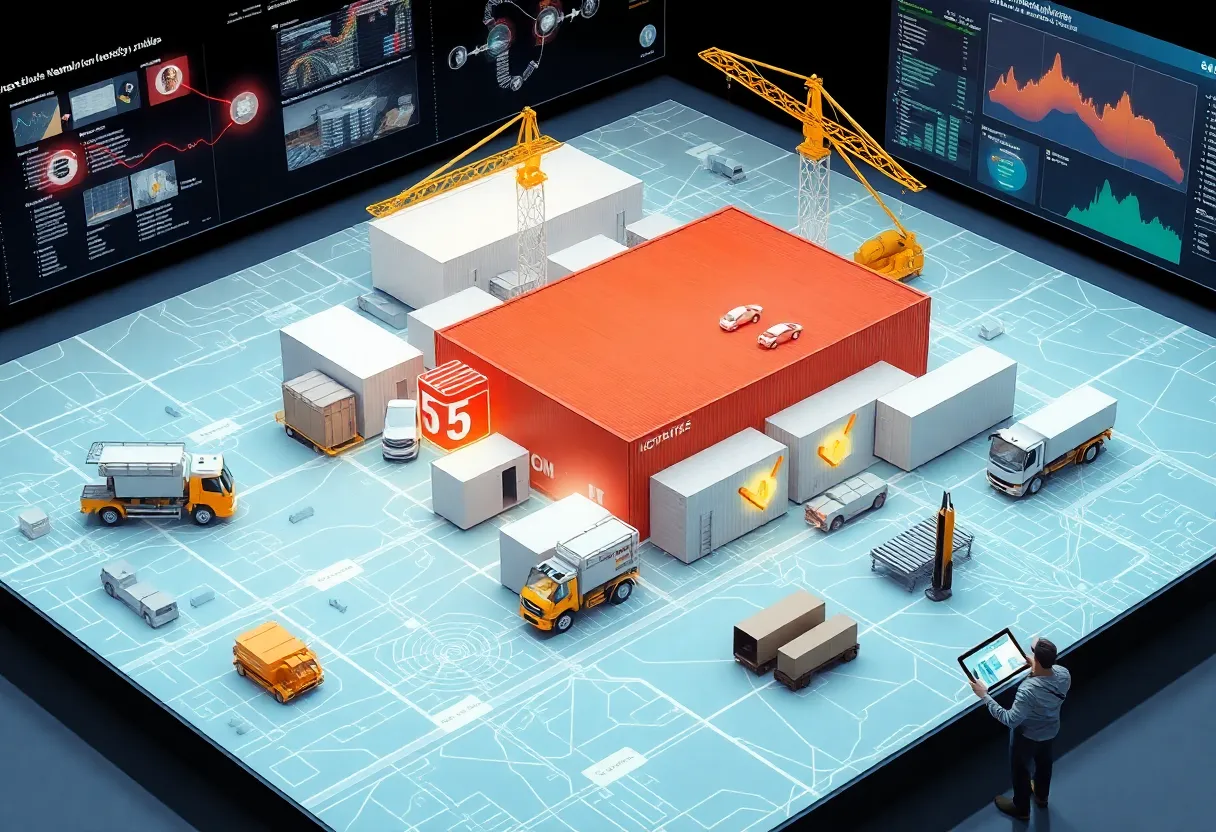Hanyang University ERICA, South Korea, August 19, 2025
News Summary
The researchers at Hanyang University ERICA’s School of Architecture & Architectural Engineering developed a digital twin-enabled facility management system (DT-FMS) for relocatable modular buildings (RMBs). The DT-FMS integrates BIM, IoT and GIS to create a live digital replica that supports real-time monitoring, logistics simulation, lifecycle performance analysis and reuse planning. A case study on a relocatable modular school in South Korea demonstrated improved module distribution, higher reuse potential, better management efficiency and potential reductions in operating costs and energy use. Organized into physical, digital and service layers, the platform enables data-driven decisions across design, transport, setup, operation and circular-economy reuse.
Hanyang University team builds digital-twin facility management system for relocatable modular buildings
Researchers at Hanyang University’s School of Architecture & Architectural Engineering have developed a new digital twin-enabled facility management system (DT-FMS) designed specifically for relocatable modular buildings (RMBs). The system links 3D building models, live sensor feeds and geographic data to enable real-time monitoring, performance analysis and logistics simulation across a building’s life cycle. A case study on a relocatable modular school in South Korea showed improved decision making for module distribution and reuse, leading to better management efficiency.
What the system does
The DT-FMS combines three core technologies: Building Information Modeling (BIM) for robust 3D models and detailed building data, Internet of Things (IoT) for real-time sensor inputs, and Geographic Information Systems (GIS) for mapping and location data. Together these form an integrated digital twin that supports live monitoring, predictive analysis and logistical planning.
Organized for practical use
The framework is built in three management layers. The physical layer tracks modular units, materials, equipment and people in real time, enabling communication among resources, engineers and site crews. The digital layer handles modelling tools, data integration and analytics that turn raw inputs into actionable insights. The service layer gives users interfaces to monitor, control and interact with the digital twin and supports operational decision making.
Case study results
To demonstrate the approach, the research team applied the DT-FMS to a relocatable modular school system in South Korea. The digital twin helped planners decide how to distribute modules, which units could be reused, and how to schedule relocations. That improved overall management efficiency for the school and, according to the researchers, has potential to cut operational costs and improve energy efficiency when applied at scale.
Why this matters for modular construction
Relocatable modular buildings are lauded as a sustainable construction method where buildings are assembled from prefabricated modules that can be easily transported. They can be quickly put together from prefabricated modules, reduce site time, lower costs and environmental impacts, and provide cleaner, safer construction conditions. However, widespread adoption has been limited by management and logistics challenges tied to tracking, relocating and reusing modules across projects. The DT-FMS aims to address those gaps by linking design, operations and geography in one digital platform.
Circular economy and reuse
Project authors argue the DT-FMS supports circular economy practices by making it easier to locate reusable modules, reconfigure units for new needs, and plan optimal relocation paths. This focus on reuse and reconfiguration is presented as a way to reduce material waste and extend the useful life of prefabricated units across repeated project cycles.
Publication and research leadership
Details of the study were published in Volume 176 of the journal Automation in Construction on 1 August 2025. The research lead is an associate professor at Hanyang University, and the team includes multiple university faculty members involved in architecture and engineering research. The team describes the DT-FMS as a tailored adaptation of digital twin concepts for the specific operational needs of RMBs.
Related university collaboration on communications research
Separately, the university announced a Memorandum of Understanding with a global network test and assurance company to collaborate on AI-RAN, 5G and 6G research at the university’s Beyond-G Global Innovation Center. Under the agreement the company will supply wireless lab test solutions, including a wireless test and optimization suite and a 6G testbed, while the university will act as an academic partner in 6G research. The Beyond-G Center was selected in 2024 for a national Global Innovation Research Center support project that provides substantial multi-year funding to accelerate next-generation communications research.
What to expect next
The DT-FMS work points to several next steps for researchers and practitioners: further field trials across different types of relocatable modular projects, integration with contractor logistics platforms, and wider adoption of combined BIM-IoT-GIS approaches for lifecycle management. If scaled, the system could make relocating, reusing and managing modular units faster and more cost effective.
Frequently Asked Questions
What is a digital twin-enabled facility management system (DT-FMS)?
The DT-FMS is a platform that creates a live digital replica of a building or set of modular units by combining 3D models, sensor data and geographic information to support monitoring, analysis and logistics decisions.
How does the DT-FMS help relocatable modular buildings?
By linking BIM, IoT and GIS, the system enables real-time tracking of modules, supports planning for relocations and reuse, and improves operational decision making—reducing waste, time and costs.
What technologies are integrated into the system?
The main components are BIM for modelling and building data, IoT for live sensor feeds, and GIS for mapping and location-based logistics planning.
Was the system tested in real projects?
Yes. The team ran a case study on a relocatable modular school in South Korea and reported improved module distribution, reuse and management efficiency.
Where was the research published?
The study appears in Volume 176 of Automation in Construction, published on 1 August 2025.
Key features at a glance
| Feature | Purpose/Benefit | Key Components |
|---|---|---|
| DT-FMS | Unified platform for lifecycle monitoring, logistics and decision support | BIM, IoT, GIS, analytics, user service interfaces |
| BIM | 3D modelling and rich building information for planning and simulations | 3D models, material/spec data, component metadata |
| IoT | Real-time sensor data for performance and condition monitoring | Environmental sensors, location trackers, equipment telematics |
| GIS | Location-based logistics and mapping for module moves and siting | Geolocation services, routing, site maps |
| Management layers | Organizes operations into physical, digital and service domains | Physical tracking, digital modelling/analytics, user control interfaces |
| Related collaboration | Communications research MOU to support next‑generation networks and testbeds | Wireless lab test solutions, 6G testbed, academic research partnership |
Deeper Dive: News & Info About This Topic
Additional Resources
- IoT World Today: Researchers develop digital twin framework to streamline construction
- Wikipedia: Digital twin
- New Civil Engineer: Researchers develop digital twin technology for modular building management
- Google Search: digital twin relocatable modular buildings
- MSN: Digital twin system transforms management of relocatable modular buildings
- Google Scholar: digital twin modular buildings
- PR Newswire: Viavi and Hanyang University sign memorandum of understanding to advance 6G research
- Encyclopedia Britannica: Hanyang University
- Telecoms.com: Viavi and South Korean university team up to work on AI RAN, 5G and 6G research
- Google News: Viavi Hanyang 6G
Author: Construction CA News
The CALIFORNIA STAFF WRITER represents the experienced team at constructioncanews.com, your go-to source for actionable local news and information in California and beyond. Specializing in "news you can use," we cover essential topics like product reviews for personal and business needs, local business directories, politics, real estate trends, neighborhood insights, and state news affecting the area—with deep expertise drawn from years of dedicated reporting and strong community input, including local press releases and business updates. We deliver top reporting on high-value events such as the Rose Parade, Coachella, Comic-Con, and the California State Fair. Our coverage extends to key organizations like the California Building Industry Association and Associated General Contractors of California, plus leading businesses in technology and entertainment that power the local economy such as Apple and Alphabet. As part of the broader network, including constructionnynews.com, constructiontxnews.com, and constructionflnews.com, we provide comprehensive, credible insights into the dynamic landscape across multiple states.




